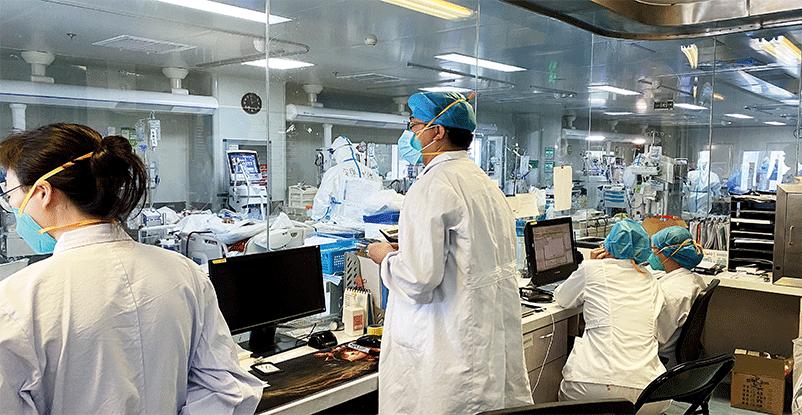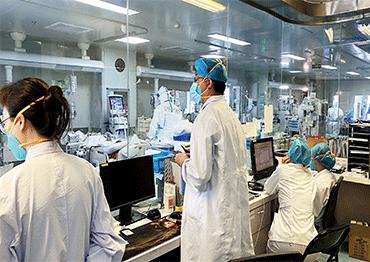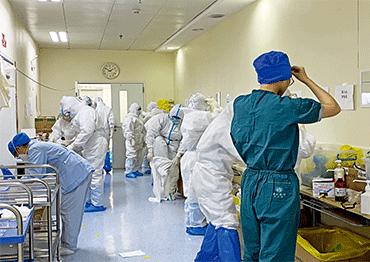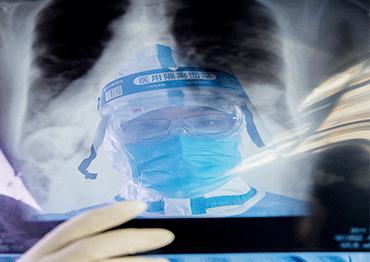Wuhan’s hospitals were overburdened in the preliminary phase of the epidemic as people flooded into hospitals following the lockdown. Data from the Wuhan Municipal Health Commission showed that fever clinics in Wuhan recorded 75,221 patients from January 22 to 27, only 3,883 of whom stayed for further medical observation.
To prevent cross-infection in hospitals, the municipal government quickly established a hierarchical system, defining district hospitals as the first site for people to check if they were infected with Covid-19, and no upper-tier hospital would admit any Covid-19 patient without a transfer letter from a district hospital. Yet, as district hospitals were not skilled at distinguishing and treating infectious diseases, the system caused many patients to be left unchecked and untreated at home. The situation did not turn around until teams of medical workers and experts were sent to Wuhan.
“We saw 200 fever patients per day at the peak (January 25 to February 14), since our hospital was the only one in the neighborhood that was able to admit fever patients and do CT tests,” an insider at the district-level Wuhan Chang Dong Hospital told NewsChina.
Wuhan started a dual-transfer system in 2006 which encouraged big hospitals to transfer patients with chronic or common diseases to district hospitals and district hospitals to transfer patients with rare and serious diseases to big hospitals. In 2008, big hospitals began to connect to district hospitals for the convenience of the transfer, and in 2015 and 2016, Wuhan issued two documents promoting and improving the hierarchical system.
But the system did not work as well as expected. According to Xiong Nian, president of Wuhan Red Cross Hospital, district hospitals actually focused on public health services, such as vaccination, instead of medical diagnosis and treatment. He revealed that among 12 district hospitals in Hankou District, at least half did not even set up a ward, and among the remaining ones with wards, half used the wards as nursing homes for seniors.
“Compared to upper-tier hospitals, district hospitals lag behind in the quality of treatment and even the varieties of medicines,” Xiong told NewsChina. “Supposing my hospital provides 1,000 kinds of medication, the number of those available in a district hospital will not exceed 100,” he added. ��
In Xiong’s opinion, the hierarchical system just served to “pump” patients from district hospitals to big ones. “When providing medical services at a [connected] district hospital, doctors from a municipal hospital would transfer all the patients to their hospitals... The district hospital’s 3 million yuan (US$426,372) social medical insurance quota would be counted in the municipal hospital’s account,” he said.
“The connection between big hospitals and district hospitals is too loose. It should have been a win-win model where doctors from big hospitals bring technologies to district hospitals and help improve the skills of the grass-roots medical workers,” said Ruan Xiaoming.
Wang Guiqiang, a chief member of the China Society of Infectious Disease, observed that Singapore’s 800 district clinics played a big role in preventing hospitals from becoming overwhelmed during the pandemic.
He suggested that China train more general practitioners for district hospitals and put the fever clinic system established following the SARS epidemic under the charge of those district GP physicians.
“District hospitals should focus more on doing preliminary tests for common diseases and take over the fever clinics from second-tier hospitals, so the second-tier ones can take charge of common infectious diseases. Top-tier hospitals will be for rare and incurable diseases. This is the [right] hierarchical system for the future,” he said.

 Old Version
Old Version


